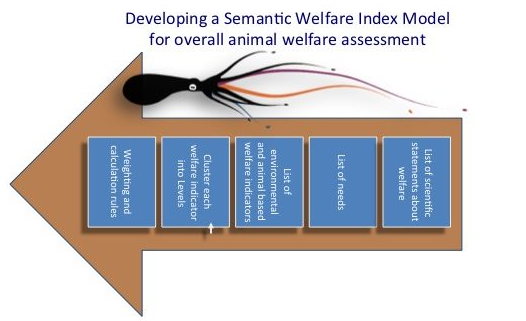WG4 CWI Database
 One of the expected outcomes of CephsInAction is the development of a model for the assessment of the Cephalopod Welfare. This is based on an Overall Welfare Assessment (OWA), as stated in FA1301-MoU, and developed according to Bradke and co-workers (see also, e.g.: Bradke et al. 1999a). The CWI is part of the objectives that this COST Action is called to develop as community.
One of the expected outcomes of CephsInAction is the development of a model for the assessment of the Cephalopod Welfare. This is based on an Overall Welfare Assessment (OWA), as stated in FA1301-MoU, and developed according to Bradke and co-workers (see also, e.g.: Bradke et al. 1999a). The CWI is part of the objectives that this COST Action is called to develop as community.
The development of a formalised assessment of animal welfare based on the meaning (i.e. semantics) of available scientific information related with cephalopods’ basic needs, and how these are related to animal welfare, is a mandatory task of CephsInAction.
WG4 is calling for your help and contribution to this important achievement!
Steps of the semantic modelling procedure
Generate statements about animal welfare (in our case cephalopods) based on a systematic review of available scientific literature.
. . . based on the statements
Determine the needs of the animals in question
Determine available welfare indicators that ‘inform’ about the fulfilment of these needs
Attribute/cluster the indicators into levels
Weighting and calculation rules (for examples of specified set of weighting categories, and a set of calculation rules utilized in the OWA as defined in Bradke et al, see above).
Definitions and operational steps
Statements: A statement is a scientific description of the requirement of an animal that may affect its welfare. It must assess the state of need of the animals and how they respond to a variety of conditions. Statements are derived through scientific knowledge about animals’ physiology and behavior to surmise their welfare state.
The scientific statements are collected from a systematic literature review by:
1) choosing a scientific paper (e.g.: published article, review, “grey” literature, “expert” opinion, book); consider that original articles are preferred rather than reviews and books, even though all sources of information are useful;
2) checking in the reference list of the CWI-database if it has already been included;
3) start looking for statements
4) focus on the results of an experimental paper and not on statements deduced through citations of other works (unless the source is a review paper)
5) statements should be species-specific and stand alone
Input Statements: once statements are identified (in a scientific source) they have to be written down in the CWI-database in the section “Welfare statements” checking the species, subclass and life stage which refer to each statement. Reference to the original work has to be included in the appropriate section of the database, and each statement has to be linked to the relative reference.
Facing possible ‘problems’ experienced when looking for statements:
i) many interesting statements are not species-specific and can therefore be lost even though very useful;
ii) “dated” findings corresponding to possible statements have been later disproved by others;
iii) statements are sometimes “hidden” in articles not directly related to welfare;
iv) statements from different sources could be in contrast with each other;
v) a definition of the life stage, especially “juveniles” has to be considered careful, possibly generating confusion
Possible solutions:
insert also statements not species-specific;
insert all the statements found (WG4 will critically review them at the end of the process)
increase the number of people working in the process so that more articles can be included
How CWI database works
CWI-database manual is available here
A short video presentation of how CWI works will be available here shortly
| M | T | W | T | F | S | S |
|---|---|---|---|---|---|---|
| 1 | 2 | |||||
| 3 | 4 | 5 | 6 | 7 | 8 | 9 |
| 10 | 11 | 12 | 13 | 14 | 15 | 16 |
| 17 | 18 | 19 | 20 | 21 | 22 | 23 |
| 24 | 25 | 26 | 27 | 28 | 29 | 30 |
| 31 | ||||||
This website is supported by COST, European COoperation in Science and Technology


